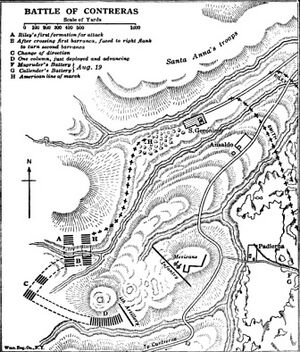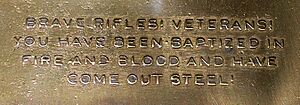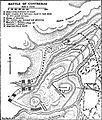Battle of Contreras facts for kids
Quick facts for kids Battle of Contreras |
|||||||
|---|---|---|---|---|---|---|---|
| Part of the Mexican–American War | |||||||
 "The Battle of Contreras" by Carl Nebel. Oil on canvas, 1851. |
|||||||
|
|||||||
| Belligerents | |||||||
| Commanders and leaders | |||||||
| Strength | |||||||
| 10,738 | 7,000 | ||||||
| Casualties and losses | |||||||
| 300 killed or wounded. | Killed and wounded unknown. 843 captured |
||||||
The Battle of Contreras, also called the Battle of Padierna, happened on August 19–20, 1847. It was a key fight near Mexico City during the Mexican–American War. American forces, led by General Winfield Scott, surprised and defeated Mexican troops. The Mexican general, Gabriel Valencia, had gone against orders from his commander, General Antonio López de Santa Anna. This battle was a big win for the U.S. forces. The two armies fought again the very next day in the Battle of Churubusco.
Contents
Why the Battle Happened
General Gabriel Valencia's army had fought in the Battle of Buena Vista earlier in 1847. After that battle, his troops were ordered to Mexico City. They marched quickly to defend the capital.
Valencia placed his troops south of the city in San Angel. He thought the U.S. forces would attack a place called San Antonio. He planned for his troops to then attack them from behind. However, General Antonio López de Santa Anna, the main Mexican commander, disagreed with Valencia's plan. Santa Anna ordered Valencia to move his troops to Coyoacan and Churubusco.
Valencia did not obey Santa Anna's orders. This caused problems for Mexico's defense plan. Santa Anna and Valencia had a personal rivalry, which was common among military leaders at the time.
General Winfield Scott and his U.S. army left Puebla on August 7, 1847. They were marching towards Mexico City. Scott decided to take a longer, southerly route to attack the city. This was to avoid a strong Mexican fort at El Peñon. Santa Anna understood Scott's plan and tried to block the new routes. He placed his own troops at San Antonio. He also ordered Valencia's 7,000 men to a strategic spot near Contreras by August 17.
The Battle Begins
General Valencia had not yet fought U.S. troops. He believed the spot Santa Anna ordered him to was not good for defense. So, he again disobeyed orders. He moved his soldiers and cannons south of Padierna. Valencia thought the U.S. forces could not cross the rough lava field called El Pedregal. He saw it as a natural barrier.
Scott wanted to attack San Antonio from the side. He ordered Captain Robert E. Lee to build a road across El Pedregal. On the morning of August 19, Lee's men met Mexican guards. U.S. troops cleared them away but then faced heavy fire from Valencia's 22 cannons. When Valencia heard the Americans were crossing El Pedregal, he was surprised. The U.S. forces suffered many losses, and Valencia thought he was winning.
More U.S. artillery arrived. Colonel Truman B. Ransom's and Lieutenant Colonel Milledge L. Bonham's troops moved closer to Valencia's camp. General Bennet Riley's brigade, supported by General George Cadwalader, took control of San Jerónimo, north of Valencia's camp. Meanwhile, General Persifor Smith's brigade, supported by General Franklin Pierce, attacked Valencia from the front.
Santa Anna was angry that Valencia had disobeyed him. Still, he tried to help Valencia's army. He moved his 3,000-man brigade to San Ángel, just north of the fighting. Night brought cold rain, and the fighting stopped for the day. The American forces had positioned themselves to stop Santa Anna from reaching Valencia's army. Santa Anna wanted Valencia to retreat in an orderly way. He told Valencia to leave his cannons and retreat with his men and smaller weapons. Valencia refused to obey this order too.
The Final Attack
During the night, Lieutenant Zealous Bates Tower found a hidden path. It was a ravine running from San Jerónimo to the back of Valencia's camp. Smith planned to use this path for a surprise attack at dawn. Lee volunteered to cross the Pedregal again during the night. This allowed Scott to plan a distraction attack.
At 5 AM, the distraction attack began. At the same time, Smith's troops attacked Valencia from behind. Valencia had not placed guards along the ravines, possibly fearing his soldiers would run away. When the attack came, Mexican forces fought hard. But within seventeen minutes, Valencia and his army fled towards San Ángel.
The U.S. forces captured 22 cannons and four Mexican generals. Two of the captured cannons had been lost by U.S. forces in an earlier battle. Valencia's repeated refusal to follow orders led to a major defeat for Mexico's most experienced soldiers.
After Valencia's defeat, U.S. troops chased the retreating Mexican soldiers towards Mexico City. Santa Anna had to move his defense to fortifications at the Churubusco River. He ordered his other generals to fall back to Churubusco. Soon, the Battle of Churubusco would begin there.
General Scott praised Captain Lee for his bravery. Lee had crossed the difficult Pedregal three times at night. Scott called it "the greatest feat of physical and moral courage performed by any individual" during the campaign. Lee was promoted for his actions.
About 843 Mexican soldiers were captured. The exact number of killed and wounded at Contreras is not known. However, General Scott estimated that on August 20, at Contreras and Churubusco combined, 4,297 Mexicans were killed or wounded. Another 2,637 were taken prisoner.
Santa Anna gave his own version of the battle on August 23, 1847. He claimed that keeping his troops in the open field would have been like a defeat.
Remembering the Battle
Even though Contreras was a big victory, there are not many pictures or prints of it from that time. The most famous image is by Carl Nebel. It is one of twelve illustrations in his 1851 book, The War between the United States and Mexico Illustrated. Nebel's picture shows the second day of the battle and is quite accurate. It focuses on the attack by Smith, Riley, and Cadwalader.
On August 20, 1847, General Scott gave a speech. The first sixteen words of this speech became very important to the Regiment of Mounted Riflemen. The regiment was tired from the fighting at Contreras. But every man stood tall as Scott approached. The General took off his hat, bowed, and said: "Brave Rifles! Veterans! You have been baptized in fire and blood and come out steel!" This famous quote is on the regiment's coat of arms. It is also the source of their motto, "Blood and Steel," and their nickname, "Brave Rifles."
Images for kids
See also
 In Spanish: Batalla de Padierna para niños
In Spanish: Batalla de Padierna para niños









